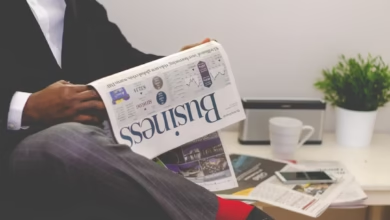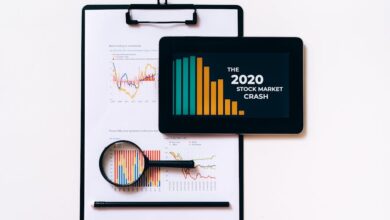Weathering the Economic Storm: Recognizing Recession Signs, Sector Impacts, and Strategic Resilience

As the global economy fluctuates, the specter of recession looms large, prompting both individuals and businesses to brace for potential challenges. Understanding the early warning signs of an economic downturn is crucial for navigating the complexities that follow. This article explores the multifaceted impacts of recessions across various sectors, shedding light on how they reshape investment strategies and consumer behavior. We will also examine the role of government stimulus in providing a buffer against economic decline and the ripple effects on global trade and supply chains. By drawing lessons from past recessions, we can better equip ourselves to face future uncertainties. Join us as we delve into essential strategies for businesses and investors to not only survive but thrive amid economic adversity.
- 1. **Recognizing the Red Flags: Early Warning Signs of an Economic Recession**
- 2. **Navigating the Storm: Sector-Specific Impacts of Recession and Investment Strategies**
1. **Recognizing the Red Flags: Early Warning Signs of an Economic Recession**
Recognizing early warning signs of an economic recession is crucial for businesses, investors, and policymakers alike. Several key indicators often signal a downturn in the economy.
One of the most telling signs is a decline in consumer spending. As households tighten their budgets in anticipation of hard times, reduced demand can lead to slower economic growth. This decline in spending is frequently accompanied by rising unemployment rates, as businesses react to decreased consumer demand by cutting back on hiring or laying off employees.
Another critical indicator is a contraction in manufacturing activity. Monitoring metrics such as the Purchasing Managers' Index (PMI) can provide insights; a PMI below 50 typically indicates a contraction in the manufacturing sector. Additionally, a decrease in housing market activity, evidenced by falling home sales and declining housing starts, can also signify impending economic troubles, as the housing sector plays a vital role in overall economic health.
Financial markets often reflect economic sentiment. A sustained decline in stock market indices can indicate investor pessimism about future growth prospects. Yield curve inversion, where short-term interest rates exceed long-term rates, has historically been a reliable predictor of recessions, as it suggests that investors expect economic slowdown.
Lastly, rising inflation alongside stagnating growth, known as stagflation, can be a particularly troubling sign. This scenario complicates monetary policy, as central banks may struggle to balance controlling inflation while stimulating economic growth.
By monitoring these indicators, stakeholders can better prepare for potential downturns and take proactive measures to mitigate their impact.
Economic recessions are complex phenomena that can have profound effects on various aspects of society and the economy. Early warning signs often include declining consumer confidence, increased unemployment claims, and a downturn in manufacturing output. These indicators can signal a slowdown in economic activity, prompting businesses and investors to reassess their strategies.
Different sectors of the economy respond uniquely to recessions. For instance, consumer discretionary sectors, such as retail and hospitality, typically suffer as people cut back on spending. Conversely, essential services like healthcare and utilities may become more resilient, as their demand remains relatively stable despite economic conditions.
During a recession, investing strategies often shift towards more conservative approaches. Investors may seek to protect their capital by focusing on value stocks, dividend-paying companies, and defensive sectors that are less sensitive to economic fluctuations. Additionally, diversification becomes crucial to mitigate risks associated with market volatility.
Government stimulus plays a vital role in mitigating the effects of recessions. By implementing monetary and fiscal policies, governments can inject liquidity into the economy, encourage consumer spending, and support struggling businesses. These measures can help stabilize markets and promote recovery, although their effectiveness can vary based on the scale and timing of the interventions.
Consumer behavior typically changes during economic downturns, with individuals prioritizing essential goods and services while reducing discretionary spending. This shift can lead to increased savings rates and a more cautious approach to borrowing, affecting overall economic growth.
Recessions also significantly impact global trade and supply chains. Slower economic activity can lead to decreased demand for imports and exports, prompting companies to reassess their supply chain strategies. Disruptions in production and logistics can have cascading effects on industries worldwide, highlighting the interconnected nature of the global economy.
Lessons learned from past recessions, such as the Great Recession of 2008, emphasize the importance of financial prudence and the need for businesses to build resilience. Companies that maintain healthy cash reserves, diversify their revenue streams, and invest in technology often emerge stronger in the aftermath of a downturn.
To prepare for and survive a recession, businesses should focus on strategic planning, cost management, and customer engagement. Developing contingency plans, enhancing operational efficiency, and maintaining open lines of communication with stakeholders can position organizations to navigate economic challenges effectively. By understanding the dynamics of a recession and proactively addressing potential risks, businesses can better withstand economic downturns and capitalize on opportunities for recovery.
2. **Navigating the Storm: Sector-Specific Impacts of Recession and Investment Strategies**
During a recession, the effects on various sectors of the economy can be profound and multifaceted. Understanding these impacts is crucial for investors looking to navigate the financial landscape effectively.
The consumer discretionary sector often bears the brunt of economic downturns, as individuals cut back on non-essential spending. Companies in retail, travel, and entertainment may see significant declines in revenue. Conversely, the consumer staples sector tends to remain more resilient, as these businesses provide essential goods such as food and household products. Investors may consider reallocating their portfolios to include stocks in consumer staples during periods of economic uncertainty.
The financial sector also faces challenges during a recession. Increased defaults on loans and decreased lending activity can lead to lower profits for banks and financial institutions. Investing in more stable, well-capitalized banks or diversifying into credit unions and other financial entities with strong fundamentals can help mitigate risks in this sector.
Industries such as healthcare and utilities often demonstrate relative stability in recessions. The demand for healthcare services remains consistent regardless of economic conditions, making healthcare stocks a potentially safer investment. Similarly, utility companies, which provide essential services, typically maintain steady cash flows, making them attractive during downturns.
Real estate can be a mixed bag. While residential real estate may suffer due to decreased consumer confidence, certain segments, like affordable housing and rental properties, may continue to perform well. Investors might explore opportunities in real estate investment trusts (REITs) that focus on sectors with stronger demand during recessions.
In technology, the impact can vary widely depending on the sub-sector. Companies that provide essential software and services may thrive, while those reliant on consumer spending for discretionary products might struggle. Investors should focus on technology firms with solid balance sheets and those that address critical needs, such as cybersecurity and remote work solutions.
As recessions often lead to increased volatility, employing investment strategies such as dollar-cost averaging can help mitigate risks. This approach involves consistently investing a fixed amount of money over time, regardless of market conditions, allowing investors to buy more shares when prices are low and fewer when prices are high.
In summary, navigating the storm of a recession requires a keen understanding of the sector-specific impacts and a strategic approach to investing. By focusing on resilient sectors, diversifying portfolios, and employing prudent investment strategies, investors can better position themselves to weather the economic downturn.
In conclusion, understanding the multifaceted dynamics of economic recessions is essential for both individuals and businesses. By recognizing early warning signs, such as declining consumer confidence and rising unemployment rates, stakeholders can position themselves ahead of potential downturns. The effects of recessions ripple across various sectors, necessitating tailored investment strategies that prioritize resilience and adaptability. Government stimulus plays a critical role in cushioning the economic blow, fostering recovery, and stimulating consumer spending.
Moreover, shifts in consumer behavior during downturns highlight the need for businesses to remain agile and responsive to changing market conditions. The interconnectedness of global trade and supply chains further complicates the recession landscape, underscoring the importance of strategic planning and diversification. Lessons drawn from past recessions provide valuable insights that remain relevant today, guiding businesses in their preparation and response strategies.
Ultimately, embracing proactive measures and cultivating financial prudence can help businesses not only survive but thrive during economic uncertainty. As we navigate the complexities of the economic cycle, staying informed and adaptable will be key to weathering future storms and emerging stronger on the other side.





